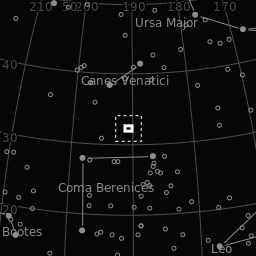
NGC 4656 und NGC 4631
Barred spiral galaxies in constellation of Canes Venatici.

Barred spiral galaxies in constellation of Canes Venatici.
The Whale Galaxy or NGC 4631 (upper right), is a barred spiral galaxy at a distance of about 28 million light years from the Milky Way. Its apparent visual magnitude is 9.0 mag.
NGC 4656/57 (lower left) is a Hubble-type SB(s)m barred spiral galaxy in the constellation Canes Venatici in the northern starry sky, estimated to be 30 million light-years from the Milky Way.
| Object: | NGC 4656 and NGC 4631 |
| Date of exposures: | 14.04.2021, 15.04.2021, 17.04.2021, 19.04.2021, 20.04.2021 |
| Distance: | 30 Mio. Lightyears |
| Exposures: | Luminance: 125 x 180", RGB: 163 x 180", Sum: 14,5 hrs |
| Telescope: | 10'', F4 Newton |
| Focal length: | 1000 mm |
| Filter: | Astrodon LRGB E-Series |
| Camera: | ASI 1600 MMC Pro |
| Guiding: | Off Axis Guider, Lodestar |
| Mount: | EQ8 |
The Wal galaxy NGC 4631 is about the size of the Milky Way and was discovered by William Herschel on March 20, 1787. NGC 4627 is a companion galaxy to the Wal galaxy (NGC 4631) and lies about 2.6' northwest of its center; the two galaxies are listed together in the Arp catalog as Arp 281. The small neighboring galaxy NGC 4627 causes some deformation of the Wal galaxy. In addition, it seems to have come close to the neighboring galaxy NGC 4656/57 more often in the past, as evidenced by hydrogen and other gas remnants found between the two galaxies today.
Of particular interest is the halo of hot gas that surrounds the galaxy and extends to a distance of 25,000 light-years from the galactic plane. High-resolution images of the halo's X-ray emission have been obtained from the Chandra research satellite. It is believed that the Milky Way is also surrounded by a similar halo.
The appearance of the galaxy NGC 4656 is reminiscent of the Small Magellanic Cloud. Because of its characteristic shape, the galaxy is sometimes jokingly called a field hockey stick. The galaxy was apparently in the past in strong interaction with the large neighboring galaxy NGC 4631 a little further to the southeast. One effect of this may be a bright, somewhat detached appearing knot at the northeastern end of the galaxy. This bright knot was cataloged as a separate object when the galaxy was discovered by Wilhelm Herschel on March 20, 1787, which led to it also being listed later in the New General Catalogue under a separate entry as NGC 4657.